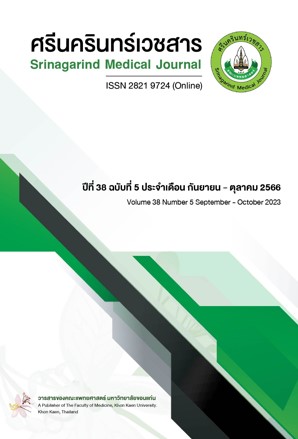Design and Development of a Constructivist Web-Based Learning Environment to Enhance Creative Thinking on the Topic of Graphic Organizer Design for Medical Illustration Students
Keywords:
web-based learning environment, constructivist, creative thinking, graphic organizerAbstract
Background and Objective: The curriculum development and learning management of the bachelor of science program in medical illustration faculty of Medicine Khon Kaen university, propose to produce graduates who have the knowledge and ability to produce medical media and enhance the necessary skills of medical illustration. Therefore, the purpose of this research was to design and development of a constructivist web-based learning environment to enhance creative thinking.
Methods: The research design was pre-experimental design (One-Group Posttest-Only Design). The target group for this research was 30 participants from 2nd year of medical illustration students, faculty of Medicine, Khon Kaen university in semester 2 of the academic year 2022. The instrument in this research was a constructivist web-based learning environment, assessment form for experts, creative thinking assessment form, creative thinking interview form, learning outcome examination, and opinion survey form. Quantitative data analysis: creative thinking, learning outcome with basic statistics including percentage, mean, and standard deviation. Qualitative data analysis: assessments for experts, opinions of students' analytical interpretation, and creative thinking analyzed by protocol analysis and analytical narrative.
Results: 1) The result in the design and development of a constructivist web-based learning environment has the efficiency in all 5 aspects. 2) The result of the student's creative thinking has been found that 29 (96.67%) students have passed the predefined criteria at 70 percent, an average score was 17.07±1.78. and student’s creative thinking from the interview has been found that students have creative thinking which consists of fluency, flexibility, originality, and elaboration. 3) The learning outcome of students has been found that 28 (93.33%) students have passed the predefined criteria at 70 percent, an average score was 16.43±1.81. and 4). The opinions of students were suitable in all 3 aspects.
Conclusions: The design and development of a constructivist web-based learning environment had quality, can be used in learning management suitable, as well as being able to develop students in creating and seeking knowledge and enhance students to have creative thinking abilities, and can be applied in the study and continue to work in the future.
References
Office of the Education Council. The national education plan B.E. 2560-2579 (2017-2036). Bangkok: Prikwaangraphic, 2017.
Guilford JP. The nature of human intelligence. New York: McGraw-Hill, 1967.
Chaijaroen S. Education technology: Principles theories to practices. Khon Kaen: Klungnanavitthaya press, 2008.
Brown JS, Collins A, Duguid P. Situated cognition and the culture of learning. Educational Researcher 1989;18(1):32–42.
Chaijaroen S. Instructional design: Principles and theories to practices. Khon Kaen: Annaoffset, 2014.
Piaget J. Part I: Cognitive development in children: Piaget development and learning. J Res Sci Teach 1964; 2(1):176–186.
Hannafin MJ, Land S, Oliver K. Open learning environments: Foundations, methods, and models. In Charles M. Reigeluth, Ed., Instructional design theories and models: A new paradigm of instructional theory. London: Lawrence Erlbaum Associates, 1999.
Vygotsky LS. Mind in society: The development of higher psychological processes. Cambridge: Harvard University Press, 1978.
Chaijaroen S. The develop web-based learning environment encouraging knowledge construction model developed based on constructivist and cognitive theories. Khon Kaen: Faculty of Education, Khon Kaen University, 2007.
Kwangmuang P. The result to learner’s critical thinking development used with constructivist learning innovation to enhance knowledge construction and critical thinking for undergraduate student. Panyapiwat J 2018;10(1):175-84.
Susing J, Chaijaroen S. Designing framework of constructivist web-based learning environments with augmented reality to enhance creative thinking on topic of animation for grade 9 students. J Informat Learn 2020;31(2):1-9.
Krabkraikaew T, Chaijaroen S. The design and development of a constructivist web-based learning environment with augmented reality to enhance creative thinking on the topic of medical computer graphic design for undergraduate students. J Informat Learn 2020;31(2):10-8.
Techapornpong O, Chaijaroen S. Framework of constructivist web-based learning environment model to enhance creative thinking: integration pedagogy and neuroscience. J Informat Learn 2017;28(1):118-29.
Wichakum A, Wattanachai S. The effects of web-based learning environment based on constructivist theory to enhance creative thinking on topic utilization of graphics for vocational students. KKU Res J Humanit Soc Sci (Graduate Studies) 2020;8(1):77-88.
Poonphol I, Chaijaroen S, Jackpeng S. The development of constructivist mobile learning environment model to foster creative thinking for high school students. J Educ Khon Kaen University 2021;44(4):151-68.
Theeranan Y, Chaijaroen S. Designing and developing a learning environment on a network developed in accordance with constructivist concepts to enhance creativity in the development of mobile applications for matthayom 3 students. J Informat Learn 2020;31(1):41-51.
Suwannasri P, Chaijaroen S. Constructivist web-based learning environment to enhance creative thinking in art subject on printing for grade 12 students. J Informat Learn 2019;30(3):28-35.
Downloads
Published
How to Cite
Issue
Section
License
Copyright (c) 2023 Srinagarind Medical Journal

This work is licensed under a Creative Commons Attribution-NonCommercial-NoDerivatives 4.0 International License.




